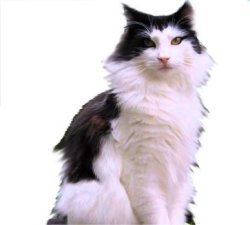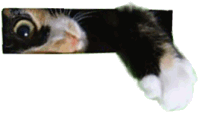Long-Haired Cats and You

Does the vet's file on your cat specify her as 'DLH'? If so, congratulations, you own a long-haired cat. More specifically, 'DLH' says that you own a moggie which has the long hair, but not the long pedigree of breeds as diverse as the elegant, fluffy Persian or the outdoorsy Maine Coon (which some people think is actually a small Labrador in disguise). There are even 'breeds' known as the British or American Longhair, though these struggle to be recognized by cat fancier's associations. However, even with these pedigree or semi-pedigree types, the most common type of long-haired cat is the basic DLH (ancestry variable or unknown).
One thing you do know is that your DLH has other long haired-cats as its forebears. This is because long-haired cats are the result of a genetic mutation. The gene is recessive, so if a long-hair is mated with a short-hair the kittens will be short-haired. However, long-haired cats will pop up in later generations. The reason that DHLs are still around despite being the result of a recessive gene, is that for some environments long-haired cats were a natural choice – for example the Norwegian Forest Cat is a hardy puffball whose fur sheds water and itself with equal ease. These cats are thought to have originally been bred by the Vikings and are at home in climates that would have the average Domestic Short Hair yowling within minutes to come indoors by the fire.
In the modern era, anyone considering getting a cat needs to ask 'long-hair or short-hair' as one of the basic questions, right after 'Can I look after her properly' and 'Do I know what I'm getting into?' There are advantages to both long-hair and short-haired cats. Long-hairs are definitely winners in the looks department. A well-groomed, long, silky fur coat looks fantastic on a cat.
However there is a downside to this as well. Ask anyone who has had to don rubber gloves and haul a resentful long-hair to the bathroom for a back-legs wash after a litter-tray visit went awry. (And sometimes it will, it will.) In fact this happens so often that vets and pet-groomers are usually familiar with the 'vanity cut' which removes hair from under the tail, back legs and other areas where feces might get matted or entangled. Another downside is that 'well-groomed' is not an option - it's essential. With a long-haired cat, brushing is needed at least twice a week to prevent the fur becoming a mass of mats and tangles. (Some breeds have straighter, stiffer hair than others, so your grooming mileage will vary.) Long, soft silky-haired breeds might need grooming four times a week, or even daily; especially if they get elderly, plump or both and can't reach the tail area as easily as they once did. See Cat Brushing for details.
Even when the cat does groom, it leaves deposits from its saliva on to the hair. This saliva forms light, scaly little specks called 'dander' which become allergens when shed in the vicinity of a susceptible victim. The more hair, and the longer it is, the more dander in the immediate environment.
As to shedding, well, long-hairs do not necessarily shed more often than short-haired cats, but because they have proportionately more hair, there is more to shed. Also some breeds of long hair have a triple coat. Spring and autumn are 'blow-out' times, when you can brush, scrape and vacuum up enough hair to make another complete cat. However, with the indoor climates and lighting conditions of the modern house, most cats will shed at least somewhat all through the year. Indoor/outdoor cats do some of their shedding outside, which is an advantage largely cancelled out by the amount of stuff that the great outdoors can leave entangled in fur.
Oddly enough, people with both long-haired and short-haired cats in the home say that the short hair is harder to get off clothes and furniture. Long hair is easier to roll up into a clump and remove. Note also that if your cat does not get groomed regularly, expect messy rolls of slimy hairball underfoot. The longer the hair, the more spectacular the hairball.
How long can long hair get? Plenty of breeds can grow their hair out to 7cm (3 inches). Some can get a lot longer, such as the internet favourite, the sadly short-lived Colonel Meow. His fur grew to an incredible 23cm (9 in). This was a world record until it was surpassed by the current record holder, Sophie, a DLH with a lot of Persian in the mix. Her hair is over 25cm (10in), though the length is mainly in her long black tail which flows behind her like a banner.
So the long and short of it is, long hair for looks, short hair for easy maintenance. Not that different to the situation with humans, really.

